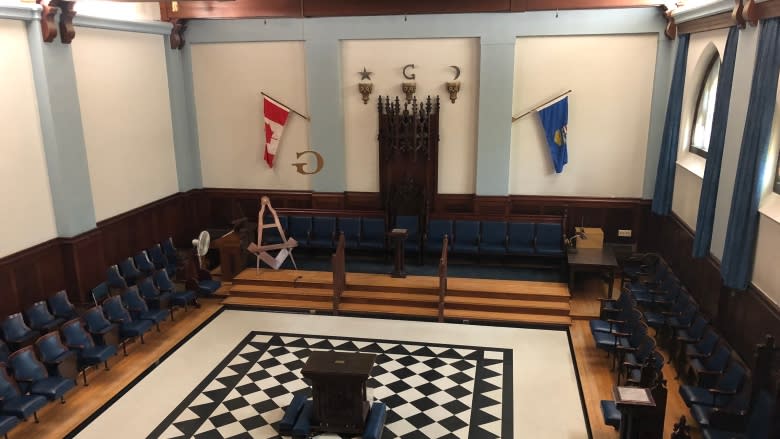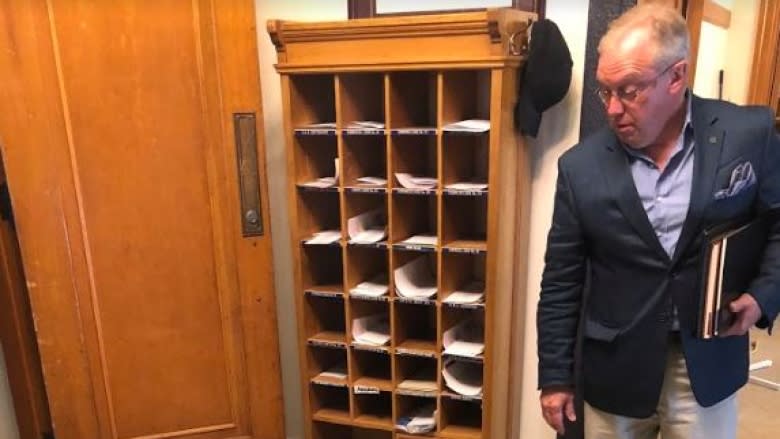Capital Foundations: A peek inside Edmonton's secretive Masonic hall
The following story is part of Capital Foundations, an ongoing series exploring Edmonton's architectural history.
Listen in weekly on CBC Radio's Edmonton AM for the latest episode, and for a little excavation of Edmonton history with architect Darrel Babuk.
There's a veil of secrecy over one of Edmonton's oldest and most mysterious organizations — but venturing through the doors of its downtown headquarters offers a peek into some of the mysteries.
The Freemasons' Hall, at 10318 100th Ave., has long been available as a venue for function rentals but is little known to most Edmontonians.
Just like the Masonic brotherhood it was designed to serve, the four-storey, Gothic-inspired hall has a sense of grandeur and mystique — a respect for history and rich sense of symbolism, said Edmonton architect Darrel Babuk.
"It's not very large but it has richly complex spaces," Babuk said. "It's a really cool building."
The building, completed in 1931, is one of the few surviving Masonic lodges in the city. It is replete with old texts, rich engravings and fraternity artifacts including gongs, tracing boards and richly embroidered robes.
The property's crowning jewel is an ornately tiled antechamber adorned with the Masonic emblems — the square and compass, the level and plumb rule. These are the manual tools of stonemasons and key symbols of the secret fraternity.
The room still regularly hosts secret meetings, overseen by a "Worshipful Master," the highest ranking brothers in the fraternity hierarchy.
The history of Freemasonry in Edmonton dates back to the early 1880s when the city's first lodge, made up of 13 chartered members who lived near Fort Edmonton, was recognized.
By the early 1920s, there were 11 growing lodges in Edmonton. With membership on the rise, the brothers petitioned for construction of the new downtown hall.
Today, the building — with its spring-loaded wooden dance floor, winding staircases and original design sketches from architect William Blakey — remains largely unaltered.
It has the remnants of the city's first lending library and the oldest passenger elevator in the province.
"Being stonemasons, they were very particular about the details," said Babuk.
"When the building was built in 1930, it was deemed to be built to the highest standard of any building in Edmonton."
A society with secrets
With their rigorous initiation ceremonies, cloistered meetings and ancient rituals, the brotherhood of Freemasons are known for keeping secrets.
Founded in London more than 300 years ago, they're the oldest, biggest and most widely recognized fraternal organization in the world.
Only men who believe in a "supreme being" are allowed and members are not recruited but must ask to join. Once vetted and approved, brothers must take an oath before they can attend regular meetings and learn the closely guarded "Masonic secrets."
The organization traces its origins to the local fraternities of medieval stonemasons who would use secret words and symbols to recognize each others' legitimacy and protect their work from outsiders.
"It's an organization and it started out as a group of stonemasons 300 years ago. Stonemasons in a guild, trying to figure how to properly lay cornerstones for example," Babuk said.
"A guild would certainly have its own trade secrets, if you will. I could tell you how to properly set a cornerstone but …."
Babuk, himself a member of the Masons, downplayed any mystery around the club which has been the subject of conjecture and conspiracy theories for decades.
He said the Masons are not a secret society but a society with secrets.
"This is a club. Many Edmontonians back in the day belonged to clubs," he said.
"This club just happened to build a really fancy building that's still with us. And I'm glad that it is."




